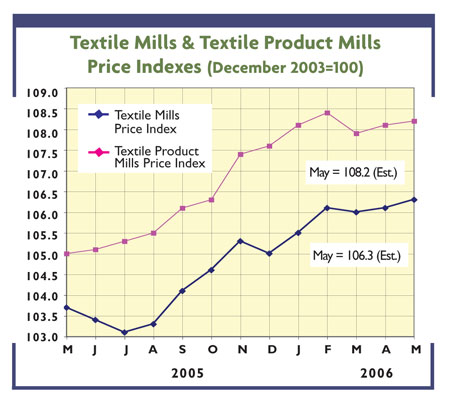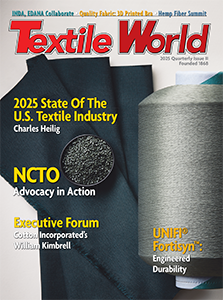T
he hottest topic from the yarn mills is the merger between Frontier Spinning Mills and
Cheraw Yarn Mills.
At a glance, it looks like a good fit for both parties. Cheraw produces more specialty items
and serves quite a few niche markets. Frontier is a major player in terms of volume and has strong
Central American business. Word is the Cheraw workers will get to keep their jobs.
The industry has seen significant recent mill shutdowns. Alice Manufacturing Co. will close
its Elljean plant in Easley, S.C., and eliminate 260 employees. Fruit of the Loom has announced the
closure of its Rabun Gap, Ga., plant, cutting 930 workers. Springs Global will close plants in
Hartwell, Ga., idling 340 associates. These closings will take considerable open-end (OE) and
air-jet capacity out of the yarn market.
Mapping The Market
Spinners’ descriptions of current running conditions and market outlooks vary somewhat this
month. The consensus is that OE remains soft, and at least one observer sees some weakness in ring
spinning.
“Demand has softened a bit for both open-end and ring-spun,” said one spinner. “It’s more
noticeable in the ring. For a while, it seemed like there was no ring-spun yarn available at any
price in the United States. That’s changed in the last week or so.”
“On the open-end side, there is availability out there,” said a multisystem spinner. “On the
ring-spun side, it appears to be quite tight or at least tight. Pricing is down on open-end.
Ring-spun pricing is still in good shape.”
Heather Yarn Demand On The Rise
“Ring-spun and open-end heather yarns, especially the ones that use bale-dyed cottons, seem to
be in good shape,” said one mill executive. “Vendors are quoting out two to three weeks or more.”
The depressed OE market seems to have picked up somewhat, at least for one mill. OE yarn
prices remain lackluster.
“Business is real good now; we’re running seven days,” said one OE spinner. “Our customers
say that their outlook is pretty good right now.”
One spinner suggested slow patches in the fourth and first quarters of 2005 and 2006,
respectively, were the result of retailers still further reducing inventory. He felt since they
have finished “making the pipeline leaner,” business for the second half of 2006 and the beginning
of 2007 should be stronger.
Further good news for the yarn mills is that business with Central America is finally on the
rebound. At the same time, spinners expressed impatience with the slow country-by-country adoption
of Central America-Dominican Republic Free Trade Agreement (CAFTA-DR).
“We still don’t have a CAFTA agreement signed by all the countries down there,” said one
spinner. “That needs to stabilize so retailers will feel comfortable sourcing from that
region.”
US Cotton Acreage On Upswing
US cotton plantings for 2006 are expected to total 14.6 million acres, 3 percent above last
year, according to the US Department of Agriculture (USDA).
Upland acreage is expected to total 14.3 million, also up 3 percent. Growers intend to
increase acreage in all the cotton-producing states except Alabama and South Carolina, where
expected acreage is down 1.8 percent and 4.1 percent, respectively. California producers expect to
plant 290,000 acres, up 26 percent from last year.
US Pima cotton growers intend to increase their plantings 24 percent from 2005, to a record
high of 334,000 acres, according to the USDA. The largest increases are projected for Arizona and
California, up 70.7 percent and 26.1 percent, respectively, according to the National Cotton
Council of America (NCC).
The latest USDA figures are higher than the NCC’s annual early-season planting intentions
survey released in February, which estimated US cotton producers intended to plant 14.4 million
acres of cotton, up 1.7 percent, and 312,000 acres of extra-long-staple cotton, up 15.2 percent.
For the 2006–07 crop year, USDA projects a US crop of 21 million bales. Mill use is set at
5.6 million bales, while exports are reported to reach 17 million bales. The estimated total
offtake stands at 22.6 million bales, resulting in ending stocks of 4.9 million bales.
May/June 2006





